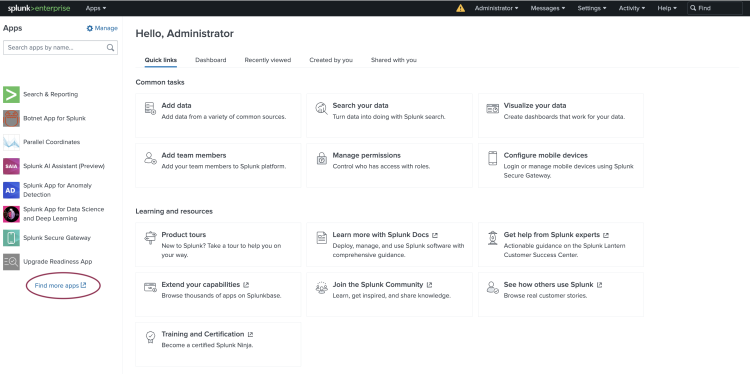Install the Splunk Machine Learning Toolkit
The Splunk Machine Learning Toolkit (MLTK) enables users to create, validate, manage, and operationalize machine learning models through a guided user interface. Follow these directions to install MLTK.
Requirements for MLTK
Running MLTK version 5.4.1 requires Splunk Enterprise 8.1.x or higher or Splunk Cloud Platform.
The Splunk Machine Learning Toolkit relies on the Python for Scientific Computing (PSC) add-on. Install or upgrade to a compatible version of the PSC add-on based on your operating system:
If you have any custom algorithms that rely on the PSC libraries, upgrading the PSC add-on impacts those algorithms. You must re-train any models (re-run the search that used the fit command) using those algorithms after you upgrade PSC.
On some Windows operating systems, installing PSC through the Splunk Manage Apps user interface results in an error. This error is usually benign and you can ignore it. In some cases, you might need to manually unpack the package in the apps directory to get past the error.
Version dependencies
For version information that includes MLTK, the PSC add-on, Python, and the Splunk platform, see Machine Learning Toolkit version dependencies matrix.
MLTK version PSC version 5.4.1 3.1.0, 4.1.0, 4.1.2, or 4.2.0 5.4.0 3.1.0, 4.1.0, or 4.1.2 5.3.3 3.0.2, 3.1.0, 4.0.0, 4.1.0, or 4.1.2 5.3.1 3.0.0, 3.0.1, or 3.0.2 5.3.0 3.0.0, 3.0.1, or 3.0.2 5.2.2 2.0.0, 2.0.1, or 2.0.2 5.2.1 2.0.0, 2.0.1, or 2.0.2 5.2.0 2.0.0, 2.0.1, or 2.0.2 5.1.0 2.0.0, 2.0.1, or 2.0.2 5.0.0 2.0.0, 2.0.1, or 2.0.2 4.5.0 1.4
Install from Manage Apps
Follow these steps to install the Splunk Machine Learning Toolkit using Manage Apps:
- Download the Splunk Machine Learning Toolkit app from Splunkbase.
- In Splunk Web, select the Manage icon next to Apps in the left navigation bar as shown in the following image:

- On the Apps page, select Install app from file.
- Select Choose File to navigate to and select the package file for the Machine Learning Toolkit. Then click Open.
- Select Upload.
- Restart your Splunk instance.
- Following the restart, you can see the MLTK app listed and available for use.
Install from Find more apps
Perform the following steps to install the Splunk Machine Learning Toolkit using Find more apps:
- Select Find more apps from the left navigation bar as shown in the following image:

- In the search field you can use keywords such as "machine learning" to find the Splunk Machine Learning Toolkit.
- Choose Install.
- Input your username and password, review the terms and conditions, then Agree and Install.
- Restart your Splunk instance.
- Following the restart, you can see the MLTK app listed on your home page and available for use.
Install from the command line
On the command line (CLI), run the command that corresponds to your operating system:
| Operating system | Command line |
|---|---|
| Unix/Linux | ./splunk install app <path/packagename> |
| Windows | splunk install app <path\packagename> |
Alternatively, unpack/unzip the file then copy the app directory to $SPLUNK_HOME/etc/apps on Unix based systems or %SPLUNK_HOME%\etc\apps on Windows systems.
Where to install
See the following table for where to install MLTK and PSC:
In a distributed deployment and depending on your environment, you might need to install MLTK and PSC in multiple places.
Splunk component Supported Y/N MLTK required PSC required Description Search Heads Yes Yes Yes Install MLTK and PSC to all search heads where the MLTK is used. Indexers No No No Do not install on Indexers. Heavy Forwarders No No No Do not install on Heavy Forwarders Universal Forwarders No No No Do not install on Universal Forwarders Light Forwarders No No No Do not install on Light Forwarders
Distributed deployment feature compatibility
See the following table for the compatibility of MLTK with Splunk distributed deployment features:
Distributed deployment feature Supported Actions required Search Head Clusters Yes Search heads must be running Splunk Enterprise version 6.6.x or higher. Indexer Clusters No Do not install on Indexer Clusters.
Splunk Machine Learning Toolkit files
You can view the source code for the Splunk Machine Learning Toolkit app in Unix and Windows environments:
- For Unix-based systems, see
$SPLUNK_HOME/etc/apps/Splunk_ML_Toolkit. - For Windows systems, see
%SPLUNK_HOME%\etc\apps\Splunk_ML_Toolkit.
The Splunk Machine Learning Toolkit is not open source and MLTK source code is provided as an example only, and for educational purposes.
See the following table for sub-directory names and descriptions:
| Subdirectory | Description |
|---|---|
appserver/static and /bin
|
Contains the underlying code files for Python, JavaScript, CSS, and images. |
/default
|
Contains configuration and dashboard files. |
/lookups
|
Contains the sample datasets used in the Showcase examples, along with more information about the datasets and their licenses. |
Bundle replication
Permanent model files, sometimes referred to as learned models or encoded lookups, are saved on disk. These files follow Splunk knowledge object rules, including permissions and bundle replication. Bundle replication is the process by which knowledge objects on the search head are distributed to the indexers.
The Splunk Machine Learning Toolkit includes a number of example model files that support the Showcase. These examples are powered by .CSV lookup files. To prevent performance issues, these .CSV lookup files are not included in MLTK bundle replication processes.
| Scoring metrics in the Splunk Machine Learning Toolkit | Install the GitHub for Machine Learning App |
This documentation applies to the following versions of Splunk® Machine Learning Toolkit: 5.4.1
 Download manual
Download manual
Feedback submitted, thanks!